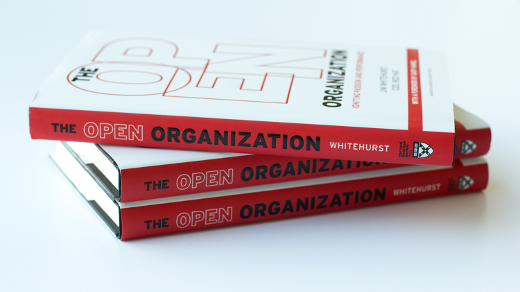Week 6 of the Open Organization book club is coming to an end, and yesterday's Twitter chat was an awesome way to wrap it up. Making inclusive decisions through transparency and participation is one of my favorite topics (and practices), and we heard some great perspectives I'm excited to share.
I opened the week talking about some of my experiences and reflecting on one of my favorite passages from The Open Organization. Making inclusive decisions through transparency and participation is hard—much harder than just sitting in a room and deciding.
Jim asks, "Why would anyone go through all this work?" It's a great question, and one that triggered a lot of thought in the book club. People who go through all the work realize how much more effective the resulting decisions are, easily making up for the extra effort.
We started our Twitter chat by discussing how we use transparency and participation in decision making. I feel I can't make a decision without inviting participation and feedback, and being transparent about the entire process, but I work at Red Hat where this is commonplace. Thomas Cameron urged us to explore what comes first—transparency or participation—in organizations where it isn't the norm:
@openorgbook Chicken/egg problem. Transparency comes b4 participation. Mgmt should use known staff as starter build from there. #OpenOrgChat
— Thomas Cameron (@thomasdcameron) October 8, 2015
Many argued that management needs to start by increasing transparency to invite participation, but some also pointed out that if you encourage and reward participation, that can lead to increased transparency at all levels.
A question I often think about provided some great insights: What are the barriers to participation in this process? Jim Whitehurst summed it up from his perspective:
A2 #openorgchat Many leaders don't believe in the value of participation to make best decisions, so they don't spend time to be open.
— Jim Whitehurst (@JWhitehurst) October 8, 2015
Like many things, you have to see it to believe it. I offered that fear of exposing your ideas is a major barrier:
Q2. Fear - of exposure, feedback, criticism. Participation takes work, transparency makes you vulnerable #OpenOrgChat
— Sam Knuth (@samfw) October 8, 2015
And Rebecca Fernandez pointed out that habit and routine are another barrier:
A2: Habit. People just aren't used to doing it this way. Followed by fear of "But what if..." scenarios. #OpenOrgChat
— Rebecca Fernandez (@ruhbehka) October 8, 2015
Understanding the barriers in your environment and proactively addressing them are essential to increase engagement.
We wrapped up by asking Jim to reflect on who he'd most like to sit down and talk to about the principles of this chapter. Before Jim could type his answer, Magnus Hedemark beat him too it:
A11: Every elected official. :) #OpenOrgChat #opengov https://t.co/eVDmIF2GdT
— Magnus Hedemark (@Magnus919) October 8, 2015
It was a great reminder that as organizations adapt and embrace new, more inclusive leadership, these principles and ideas can stretch far beyond the corporate world.






1 Comment